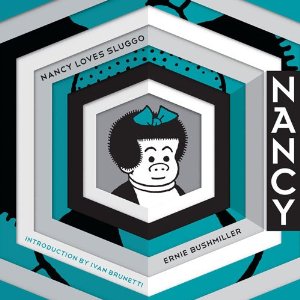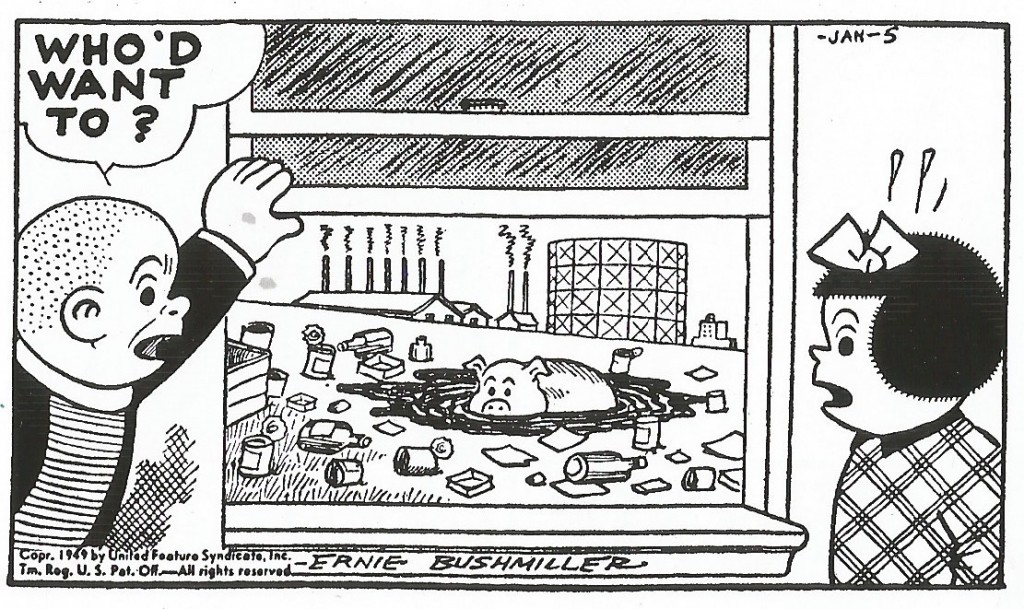Nancy Loves Sluggo
By Ernie Bushmiller
Introduction by Ivan Brunetti
Fantagraphics, 2014
Nancy connoisseurs know all about the three rocks. They are the icon of suburban outdoorsiness in Ernie Bushmiller’s famed mainstream comic strip about an impetuous little girl with a horizontal black line for a nose.
The three rocks have been exalted and elaborated upon by such celebrated modern cartoonists and graphic analysts as Bill Griffith (Zippy the Pinhead), Scott (Understanding Comics) McCloud, Mark (We All Die Alone) Newgarden, Art (Maus) Spiegelman and current Nancy cartoonist Guy Gilchrist (who avers that Nancy’s hometown is Three Rocks, Tennessee).
Ivan Brunetti, who once submitted samples for consideration as a Nancy writer/artist and who created the two-volume Anthology of Graphic Fiction, Cartoons, and True Stories for Yale Press, doesn’t mention the three rocks in his introduction to the just-released third volume of collected Bushmiller Nancy strips, Nancy Loves Sluggo. What he does mention, regarding his brief failed attempt to take over Nancy, is “how much I loved drawing Sluggo (and especially his decrepit house).”
There are precious few three-rocks arrangements in Nancy Loves Sluggo, which includes all the daily Nancy strips from 1949 through 1951. Bushmiller would do Nancy until 1982, and the golden age of the three rocks was probably the 1970s.
What Nancy Loves Sluggo does have is a couple of strips showing the consistency with which Ernie Bushmiller rendered Sluggo’s backyard.
On Jan. 5, 1949, Nancy berates Sluggo for not washing his window. “I like it dis way,” the stubble-headed hobo child retorts.
“But you can’t see out,” Nancy insists.
“Who’d want to?,” Sluggo exclaims, throwing open the window to reveal factory smokestacks, a vista-blocking silo, a slew of discarded cans and papers, and a pig wallowing in a mud puddle.
A year later, on Jan. 25, 1950, Sluggo is elated. “Hey Nancy—one of my chicks just hatched. Wonder what he thinks he first looks around.”
Nancy: “How much better the view was inside.”
And there’s the yard again. Same silo, same cans and bottles and paper, same tired pig in the same dark puddle. There are a few changes—instead of a factory, there’s an abandoned house, and the yard is bordered by a delapidated picket fence and a wooden keg full of trash. But Sluggo’s environment is secure. Here’s a boy whose home is so wretched a pig is happy to stay there too.
Bushmiller is renowned as a gag artist. Every panel, it would seem, is created to serve the punchline of that single day’s strip. Yet, reading Nancy in order, you realize how much continuity, how much character development, how much serialization actually exists in the quick-joke Nancy universe. This latest volume contains over a week of strips when Sluggo gains weight, a separate long sequence when Nancy moons over a movie star, and another bunch of strips when a Spanish girl moves to town. There are the abstractions, obsessions and comic exaggerations we associate with classic Nancy, but there are also reasons to appreciate the strip in grand lumps and not just in bite-sized daily single-joke servings.
The Nancy books from Fantagraphics—Nancy is Happy, Nancy Loves Christmas and now Nancy Loves Sluggo—are an incredible resource for Bushmiller devotees. Kitchen Sink Press put out some cherished thematic collections of Nancy strips back (Nancy Eats Food; Bums, Beatniks and Hippies; Nancy’s Pets; Dreams and Schemes; How Sluggo Survives!) back in the ‘80s, around the same time that comics historian Brian Walker published the exceptional anthology/biography The Best of Ernie Bushmiller’s Nancy. But until now there has not been a comprehensive grouping of all the daily Nancys, where you can trace the rocks, pinpoint the pigs and admire the hairbowed breadth of it all.


